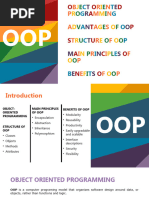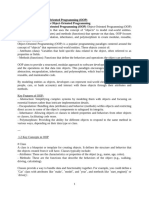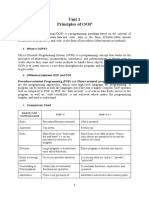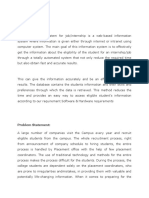0 ratings0% found this document useful (0 votes)
18 viewsIntroduction To Object-Oriented Programming (OOP)
The document discusses object-oriented programming concepts including classes, objects, encapsulation, inheritance, polymorphism and benefits of OOP. It compares OOP to procedural programming and provides best practices and tips for writing effective object-oriented code.
Uploaded by
نـــجــم الــديــن جـــــرايCopyright
© © All Rights Reserved
Available Formats
Download as PPTX, PDF, TXT or read online on Scribd
0 ratings0% found this document useful (0 votes)
18 viewsIntroduction To Object-Oriented Programming (OOP)
The document discusses object-oriented programming concepts including classes, objects, encapsulation, inheritance, polymorphism and benefits of OOP. It compares OOP to procedural programming and provides best practices and tips for writing effective object-oriented code.
Uploaded by
نـــجــم الــديــن جـــــرايCopyright
© © All Rights Reserved
Available Formats
Download as PPTX, PDF, TXT or read online on Scribd
You are on page 1/ 14
Introduction to Object-
Oriented Programming (OOP)
Understanding the Basics and Benefits
Content Plan
• 0. PP
• 1. Introduction to OOP
• 2. Core Concepts of OOP
• 3. Class and Object
• 4. Encapsulation
• 5. Inheritance
• 6. Polymorphism
• 7. Benefits of OOP
• 8. Comparison with Procedural Programming
• 9. Best Practices and Tips
• 10. Conclusion
Paradigms of Programming
Introduction to OOP
Definition
Object-oriented programming (OOP) is a programming paradigm that
organizes data and behaviors into reusable structures called objects. It
emphasizes the concept of objects, which are instances of classes that
encapsulate data and methods.
Core Concepts of OOP
• Classes and Objects: Define classes and objects, explaining their
relationship.
• Encapsulation: Explain encapsulation and its importance in OOP.
• Inheritance and Polymorphism: Introduce inheritance and
polymorphism concepts.
Class and Object
• Explanation of Classes: Define a class as
a template for creating objects,
consisting of attributes (data fields) and
methods (functions).
• Explanation of Objects: Describe objects
as instances of classes, with their own
unique state (attributes) and behavior
(methods).
• Example: Provide a code example
illustrating the definition of a class (e.g.,
'Car') with attributes (e.g., 'make',
'model') and methods (e.g., 'drive',
'stop').
Encapsulation
• Definition of Encapsulation: Explain encapsulation as the bundling of
data and methods within a class, with access restricted to the class's
methods.
• Access Specifiers: Detail access specifiers such as public, private, and
protected, explaining their role in controlling access to class
members.
Inheritance
• Definition of Inheritance: Define
inheritance as the ability of a class to
inherit properties and methods from its
superclass (base class).
• Base and Derived Classes: Illustrate the
relationship between base classes and
derived classes, highlighting the reuse of
code and the concept of 'is-a'
relationships.
• Example: Provide a code example
demonstrating inheritance, with a base
class (e.g., 'Animal') and derived classes
(e.g., 'Dog,' 'Cat') inheriting from it.
Polymorphism
• Definition of Polymorphism: Explain
polymorphism as the ability of objects
to take on multiple forms, allowing for
flexible and dynamic behavior.
• Method Overloading: Define method
overloading as the ability to define
multiple methods with the same
name but different parameters.
• Method Overriding: Define method
overriding as the ability to provide a
new implementation for a method
inherited from a superclass.
Benefits of OOP
• Reusability: Discuss how OOP promotes code reuse through the
creation of classes and objects, reducing redundancy and enhancing
maintainability.
• Modularity and Maintainability: Highlight how OOP encourages
modular design, allowing for the development of complex systems
composed of smaller, reusable components that can be easily
maintained and updated.
Comparison with Procedural Programming
• Contrasting OOP with Procedural Programming: Compare and
contrast OOP with procedural programming, highlighting differences
in approach, code organization, and problem-solving.
• Advantages and Disadvantages: Discuss the advantages (e.g., code
reuse, scalability) and disadvantages (e.g., potential for complexity,
performance overhead) of each programming paradigm.
Best Practices and Tips
• Design Principles (SOLID): Introduce the SOLID principles (Single
Responsibility, Open/Closed, Liskov Substitution, Interface
Segregation, Dependency Inversion) as guidelines for writing clean,
maintainable, and scalable code.
• Common Pitfalls and Tips: Highlight common pitfalls in OOP (e.g.,
tight coupling, violation of encapsulation) and provide tips for writing
effective object-oriented code (e.g., favor composition over
inheritance, follow naming conventions).
Conclusion
Recap key concepts covered in the presentation, including classes, objects,
encapsulation, inheritance, polymorphism, and the benefits of OOP.
Emphasize the importance of OOP in modern software development and
encourage further exploration of the topic.
Slide Content Plan
• 1. Introduction to OOP
• 2. Core Concepts of OOP
• 3. Class and Object
• 4. Encapsulation
• 5. Inheritance
• 6. Polymorphism
• 7. Benefits of OOP
• 8. Comparison with Procedural Programming
• 9. Best Practices and Tips
• 10. Conclusion
You might also like
- Dynamic Instructional Design Lesson Plan ExampleNo ratings yetDynamic Instructional Design Lesson Plan Example2 pages
- Updated Lecture Notes On Object Oriented Programming-1No ratings yetUpdated Lecture Notes On Object Oriented Programming-119 pages
- Object-Oriented Programming (OOP) and Its Features: CopilotNo ratings yetObject-Oriented Programming (OOP) and Its Features: Copilot2 pages
- Introduction To Object-Oriented Programming: Objects and Classes Encapsulation and Information Hiding Mental ExercisesNo ratings yetIntroduction To Object-Oriented Programming: Objects and Classes Encapsulation and Information Hiding Mental Exercises32 pages
- Introduction To Object-Oriented Programming: Objects and Classes Encapsulation and Information Hiding Mental ExercisesNo ratings yetIntroduction To Object-Oriented Programming: Objects and Classes Encapsulation and Information Hiding Mental Exercises32 pages
- Object Oriented Programming With C - Ug1No ratings yetObject Oriented Programming With C - Ug192 pages
- most important oops question for interviewNo ratings yetmost important oops question for interview72 pages
- Unit 1 Principles of OOP: What Is OOPS?No ratings yetUnit 1 Principles of OOP: What Is OOPS?55 pages
- Unit-1 (Part-A) Notes of OOPS by Updesh Kumar - UpdatedNo ratings yetUnit-1 (Part-A) Notes of OOPS by Updesh Kumar - Updated29 pages
- Lesson 7 Oop Fundamentals Diit PPT Dcit 50 OopNo ratings yetLesson 7 Oop Fundamentals Diit PPT Dcit 50 Oop23 pages
- Design Patterns Made Easy: A Practical Guide with ExamplesFrom EverandDesign Patterns Made Easy: A Practical Guide with ExamplesNo ratings yet
- TB150[CX2510(H),CX2510(H)(N)-EU]_WM-ALL-200327 402No ratings yetTB150[CX2510(H),CX2510(H)(N)-EU]_WM-ALL-200327 4021 page
- X2Change Flourometer Quickstart Guide V1.0No ratings yetX2Change Flourometer Quickstart Guide V1.07 pages
- Chapter 18: Concurrency Control Techniques: Answers To Selected ExercisesNo ratings yetChapter 18: Concurrency Control Techniques: Answers To Selected Exercises9 pages
- SET-37. Touch Screen Controlled Lamp DimmerNo ratings yetSET-37. Touch Screen Controlled Lamp Dimmer4 pages
- TYKMA Electrox Product Brochure REV0922No ratings yetTYKMA Electrox Product Brochure REV092228 pages
- Journal of Economics, Finance and Management Studies: Aulia Rahma Yeni, Monica Weni PratiwiNo ratings yetJournal of Economics, Finance and Management Studies: Aulia Rahma Yeni, Monica Weni Pratiwi6 pages
- Piccolino Manual: Installation of The Required Software, and Connection of The HardwareNo ratings yetPiccolino Manual: Installation of The Required Software, and Connection of The Hardware55 pages
- ةعجارم ةلئسأ Review Questions: Mohammed S. AlmosawiNo ratings yetةعجارم ةلئسأ Review Questions: Mohammed S. Almosawi12 pages
- Wal Mart: Supply Chain Management: K.Varun 123511No ratings yetWal Mart: Supply Chain Management: K.Varun 12351120 pages
- How To Document The Architecture of Your Application Using UML and More100% (2)How To Document The Architecture of Your Application Using UML and More57 pages
- Age Site Pages Torrents Trackers Seeds Leechers: WWW - Hightorrent.toNo ratings yetAge Site Pages Torrents Trackers Seeds Leechers: WWW - Hightorrent.to17 pages
- Student Eligibility System For Job or InternshipNo ratings yetStudent Eligibility System For Job or Internship13 pages































































































